
About UsThe Numismatic Bibliomania Society is a non-profit organization promoting numismatic literature. For more information please see our web site at coinbooks.org SubscriptionsThose wishing to become new E-Sylum subscribers (or wishing to Unsubscribe) can go to the following web page link MembershipThere is a membership application available on the web site Membership Application To join, print the application and return it with your check to the address printed on the application. Membership is only $15 to addresses in the U.S., $20 for First Class mail, and $25 elsewhere. For those without web access, write to: David M. Sundman, Secretary/TreasurerNumismatic Bibliomania
Society AsylumFor Asylum mailing address changes and other membership questions, contact David at this email address: dsundman@LittletonCoin.com SubmissionsTo submit items for publication in The E-Sylum, just Reply to this message, or write to the Editor at this address: whomren@coinlibrary.com
BUY THE BOOK BEFORE THE COINYou won't regret it! |
- WAYNE'S WORDS: THE E-SYLUM SEPTEMBER 11, 2011
- MARK BLACKBURN HAS PASSED
- DAVIS NUMISMATIC LITERATURE AT THE 2011 PHILADELPHIA WHITMAN SHOW
- LAKE BOOKS 109TH MAIL-BID SALE CATALOG AVAILABLE
- NEW BOOK: THE ALEXANDER MEDALLION BY HOLT AND BOPEARACHCHI
- NEW EDITION: GOOD MONEY BY SELGIN NOW AVAILABLE IN PAPERBACK
- BOOK REVIEW: COLT CYLINDER SCENES 1847-1851
- MORE VISITOR NOTES ON THE BURD NUMISMATIC LIBRARY
- DICK JOHNSON: LAST WORD ON NASCA, AND A NEW TOPIC
- MORE ON TEMPORARY U.S. MINT FACILITIES
- U.S. MINT EMPLOYEE STOLE AND SOLD ERROR COINS
- WASHINGTON POST INTERVIEWS BEP EMPLOYEE
- ERNIE NAGY'S 2011 CHICAGO ANA DIARY
- THIAN'S COMPILATIONS OF CONFEDERATE TREASURY DOCUMENTS
- BYRD POLAR FLIGHTS MEDAL
- QUERY: ALASKA FISH MONEY INFORMATION SOUGHT
- INSPIRATIONS FOR HOBO NICKEL CARVINGS
- RECORD PRICE FOR AN AUSTRALIAN VICTORIA CROSS MEDAL
- NOTES FROM E-SYLUM READERS: SEPTEMBER 11, 2011
- ROMAN REPUBLICAN COINS IN NUMISMATICA ARS CLASSICA SALE
- MORE ON THE LEGALITY OF LIBERTY DOLLARS
- RENAISSANCE EXHIBIT INCLUDING MEDALS HEADED FOR NEW YORK
- ANOTHER NEW ZEALAND MEDAL THIEF CAUGHT
- BOOKSHELVES EVOLVE FOR THE POST-BOOK ERA
- FEATURED WEB PAGE: U.S. MINT'S SEPTEMBER 11TH MEDALS
WAYNE'S WORDS: THE E-SYLUM SEPTEMBER 11, 2011

Among our new subscribers this week are Ernie Nagy, courtesy of John Mutch, Alan Workman, courtesy of Fred Lake, and Casey Collins. Welcome aboard! We have 1,457 email subscribers, plus 161 followers on Facebook, including Ele Gio Giunta.
Welcome to the September 11, 2011 issue of The E-Sylum. Thankfully, there is nothing but numismatic news in this issue, unlike that of ten years ago this week.
This week we open with sad news from the U.K. - Dr. Mark Blackburn of Fitzwilliam Numismatic Collection at Cambridge has passed. Next are notes from numismatic literature dealers Charlie Davis and Fred Lake, followed by two new book announcements and my review of Arthur Tobias' new book relating to W. L. Ormsby.
Other topics include Charles Wormser and the New Netherlands Coin Co., good and bad employees of the Bureau of Engraving and Printing and the U.S. Mint, inspirations for Hobo Nickel carvings and the legality of collecting Liberty Dollars.
To learn more about John Ford and NASCA's photocopy machine, (very) temporary U.S. Mint facilities, coins of Liberia, and Alaska Fish Money, read on. Have a great week, everyone!
MARK BLACKBURN HAS PASSED
Dick Doty of the Smithsonian Institution writes:
I've got some sad news. Mark Blackburn, Senior Keeper of the Fitzwilliam Numismatic Collection at Cambridge, died on the first after a long battle with melanoma.
Hadrien Rambach forwarded a link to this announcement:
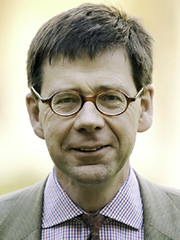 Caius College Cambridge announces with great sadness the death on 1 September of Dr Mark Blackburn, at the age of 58. Dr Blackburn, a Fellow of Caius since 2005, was a hugely distinguished and widely published monetary historian. He was University Reader in Numismatics and Monetary History and Keeper of Coins and Medals at the Fitzwilliam Museum where he transformed his department. He served the College with great commitment as Registrary between 2007 and 2010. The funeral will be on Monday 12 September at St Andrew's Church, Chesterton, at 2.00pm, followed by a private cremation.
Caius College Cambridge announces with great sadness the death on 1 September of Dr Mark Blackburn, at the age of 58. Dr Blackburn, a Fellow of Caius since 2005, was a hugely distinguished and widely published monetary historian. He was University Reader in Numismatics and Monetary History and Keeper of Coins and Medals at the Fitzwilliam Museum where he transformed his department. He served the College with great commitment as Registrary between 2007 and 2010. The funeral will be on Monday 12 September at St Andrew's Church, Chesterton, at 2.00pm, followed by a private cremation.
To read the complete article, see: Dr Mark Blackburn (www.cai.cam.ac.uk/node/84517)
DAVIS NUMISMATIC LITERATURE AT THE 2011 PHILADELPHIA WHITMAN SHOW
I will have tables at the Philadelphia Whitman show September 14-17 and will bring for display selected lots from our October 1 mail bid sale. Those wishing to see specific lots should contact me by Tuesday and I will make every effort to bring them
Charles Davis
Numismatic Literature
P.O. Box 547
Wenham, MA 01984
Tel: (978) 468 2933
Fax: (978) 468 7893
LAKE BOOKS 109TH MAIL-BID SALE CATALOG AVAILABLE
Lake Books announces that its 109th mail-bid sale of numismatic literature is now available on their web site at www.lakebooks.com/current.html . The sale features selections from the library of Dr. Allen Axenfield and contains reference material on U. S. coins, World and Ancient coins, Paper Money, Tokens and Medals, and numismatic ephemera.
Of particular note are long runs of "The Numismatic Chronicle" from the Royal Numismatic Society and many of the "Sylloge of Coins of the British Isles" .Bids may be placed via email, telephone, fax or US Mail until the closing time of 5:00 PM (EDT) on Tuesday, October 4, 2011.Remember to bid early as ties are won by the earliest bid received.
Good luck with your bidding, Fred
Lake Books
6822 22nd Ave. N.
St. Petersburg, FL 33710
727-343-8055 Fax 727-345-3750
NEW BOOK: THE ALEXANDER MEDALLION BY HOLT AND BOPEARACHCHI
Responding to Howard Cohen's request last week regarding an article by Frank Holt about "the spectacular Gold Double Daric of Alexander the Great", Ted Buttrey writes:
Holt's work on the Gold Double Daric, now called the Alexander Medallion, has been published as (or rather, in) a book: Frank Holt and Osmund Bopearachchi, "The Alexander Medaillion. Exploring the origins of a unique artefact" (published by the authors, 2011), which brings together several papers on this subject. The authors consider the serious problem of the coin's authenticity, concluding that it is genuinely ancient. But there are many who do not accept the piece, and there is likely to be controversy for a long time to come.
Howard Cohen writes:
Thanks for posting my request via Anne Bentley of the Massachusetts Historical Society. I recently received e-mail from Frank Holt. He states his papers have just been published in book form, titled "The Alexander Medallion" The book is coauthored by Osmund Bopearachchi, and published in France by Imago Lattara. At present I have not found any book dealers with copies.
To read the earlier E-Sylum article, see: ARTICLE ON GOLD DOUBLE DARIC OF ALEXANDER THE GREAT SOUGHT (www.coinbooks.org/esylum_v14n37a10.html)
NEW EDITION: GOOD MONEY BY SELGIN NOW AVAILABLE IN PAPERBACK
Author George Selgin writes:
Just a quick note to let you know that Good Money was recently published in a paperback edition, with a new preface. The paperback is otherwise identical to the hardcover, including the color plate insert. It's available from the Independent Institute for $22.10. Here's the store link: www.independent.org/store/book_detail.asp?bookID=75
 In Good Money, George Selgin tells the fascinating story of the important yet almost unknown episode in the history of money—British manufacturers' challenge to the Crown's monopoly on coinage.
In Good Money, George Selgin tells the fascinating story of the important yet almost unknown episode in the history of money—British manufacturers' challenge to the Crown's monopoly on coinage.
In the 1780s, when the Industrial Revolution was gathering momentum, the Royal Mint failed to produce enough small-denomination coinage for factory owners to pay their workers. As the currency shortage threatened to derail industrial progress, manufacturers began to mint custom-made coins, called "tradesman's tokens." Rapidly gaining wide acceptance, these tokens served as the nation's most popular currency for wages and retail sales until 1821, when the Crown outlawed all moneys except its own.
Good Money not only examines the crucial role of private coinage in fueling Great Britain's Industrial Revolution, but it also challenges beliefs upon which all modern government-currency monopolies rest. It thereby sheds light on contemporary private-sector alternatives to government-issued money, such as digital monies, cash cards, electronic funds transfer, and (outside of the United States) spontaneous "dollarization."
To read the earlier E-Sylum articles, see:
NEW BOOK: 'GOOD MONEY' BY GEORGE SELGIN
(www.coinbooks.org/esylum_v11n24a03.html)
REVIEWS: GOOD MONEY BY GEORGE SELGIN
(www.coinbooks.org/esylum_v11n33a09.html)
THE BOOK BAZARRE
BOOK REVIEW: COLT CYLINDER SCENES 1847-1851
As announced earlier in The E-Sylum, Arthur Tobias has written a new book relating to W.L. Ormsby, author of one of the rarest books in U.S. numismatic Literature, Bank Note Engraving. He kindly provided me with a review copy and furnished some excerpts from the text. Here they are, along with my comments.

From the Introduction:
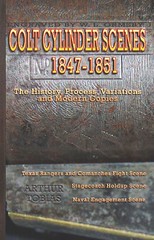 This is a book about the three most widely known cylinder Scenes engraved by Waterman Lilly Ormsby for Sam Colt, used on some of the most popular products of that illustrious gun maker. In the order in which they appeared on the historical stage they are the Texas Rangers and Comanches Fight (Rangers), the Stagecoach Holdup (Stagecoach) and the Naval Engagement (Naval) Scenes. This book is also about Ormsby the artist and engraver and his methods. His ingenuity, creativity and personality are central to the story of the Colt Scenes and therefore the revolvers they graced.
This is a book about the three most widely known cylinder Scenes engraved by Waterman Lilly Ormsby for Sam Colt, used on some of the most popular products of that illustrious gun maker. In the order in which they appeared on the historical stage they are the Texas Rangers and Comanches Fight (Rangers), the Stagecoach Holdup (Stagecoach) and the Naval Engagement (Naval) Scenes. This book is also about Ormsby the artist and engraver and his methods. His ingenuity, creativity and personality are central to the story of the Colt Scenes and therefore the revolvers they graced.
Books like Arthur's are among the favorites in my numismatic library - the ones that are interesting and relevant to numismatics, yet not directly about numismatics. It's books like these that cross over into other areas that illuminate the whole of someone's life work - not just the numismatic parts, but all of it.
Through this little volume I learned a great deal about Waterman Lilly Ormsby, his life's work, his talents and his business projects as well as learning something more about his numismatic (and bibliophilic) projects.
From Chapter One: W. L. Ormsby, His Process:
Mention Waterman Lilly Ormsby to a member of the numismatic fraternity and you will hear about the famous engraver's many banknote designs of the mid-19th century, rarely a word about Colt cylinder scenes. Mention W. L. Ormsby to a collector of 19th century American engravings on steel and you will hear of the famous copy of Trumbull's Declaration of Independence that hangs today in the White House.
Mention Ormsby to a Colt collector and you will stimulate thoughts of the topics of this tome, cylinder Scenes. Rarely will you hear anything to do with banknotes or framed prints. The disparate collecting communities are not often aware of their mutual interests and how they are pooled in the life and works of this one original, irascible American artist, engraver and inventor.
Hopefully this book, with its crossover niche, will entice new collectors to the obsolete paper money field. Or encourage numismatists to take up arms and collect Colt revolvers!
Concurrent with Colt's new arms venture in the late 1840s W. L. Ormsby had begun developing his anti-counterfeiting schemes involving unique, engraved images. These ideas would come to closely support the patents that Colt had actively protected since 1835. Ormsby's ideas were publicly promoted in his 1852 book Bank-Note Engraving. The sole, stated purpose of the large tome was to promote a method to defeat the efforts of mid-19th century America's numerous banknote counterfeiters. Though much talked about at the time, in the end Ormsby's proposal had little impact on banknote design.
Most of Ormsby's banknote output was of the clip-art variety, as seen in the $10 note on the Commercial Bank of Terre Haute, Indiana from 1858. But he did have a better idea. In his book he promoted the idea of the "single vignette bank-note," which he also called the "unit system." By this method the entire surface of the paper was covered by one, unbroken design engraved from a unique plate featuring complex scenes with the text interwoven. The images were supposed to be copyrighted and the printing plates jealously guarded so as not to be duplicated by direct mechanical or electrotyping means.
Neither the Colt Scenes nor Bank-Note Engraving was the last hurrah for W. L. Ormsby, Sr. In 1853 he founded the New York Bank Note Company. Its imprimatur and the well-known "W. L. Ormsby, New York." grace many notes issued by banks from New Hampshire to Utah in the 1850s.
The book illustrates one of Ormsby's bank notes and as a paper money collector these would be interesting items to have, now knowing more about their maker.
The book is primarily a study of its title subject, the Colt cylinder scenes. I enjoyed reading the historical and artistic background of the scenes Ormsby and Colt choose to use. Arthur's book reminded me of another favorite series of small but incredibly useful books in the obsolete paper money field - Roger Durand's "Interesting Notes..." series, where he provides background information on the images used to adorn many obsolete U.S. bank notes.
Although Arthur provided me with a good deal of text from his book, I'll stop with the above excerpts lest I give away all the best parts (and there are plenty). In short, I recommend it for any E-Sylum reader interested in numismatic literature, obsolete paper money, engraving, art (or Colt revolvers).
To order: In the U.S. send check or money order for $24.95 ($19.95 + $5 S&H) to: Arthur Tobias, P.O. Box 19981, Los Angeles, CA 90019.
For more information (or to order online) see: www.coltcylinderscenes.com .
To read the earlier E-Sylum article, see: NEW BOOK: COLT CYLINDER SCENES, 1847-1851 (www.coinbooks.org/esylum_v14n34a09.html)
MORE VISITOR NOTES ON THE BURD NUMISMATIC LIBRARY
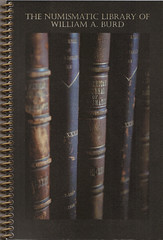 Elizabeth Hahn of the American Numismatic Society writes:
Elizabeth Hahn of the American Numismatic Society writes:
I had a few quick comments to add to the visitor notes on the Burd numismatic library visit in Chicago for The E-Sylum.
As I still find myself catching up on various projects from the summer, I was a little late to read the most recent issues of the Esylum. I wanted to add some (perhaps belated) remarks about the truly enjoyable trip to visit Bill Burd's numismatic library in Chicago. It was a delight not only to see his outstanding collections but also to meet and mingle with the other participants, many of whom I correspond with, but had not yet met in person.
Although budget considerations (rather than aesthetic ones) often dictate the books we are able to acquire for the ANS Library, this does not mean that I am not frequently attracted to beautiful books, and Mr. Burd's library has a great deal of attractively bound and excellently preserved items that caught my eye. In particular, I was especially drawn over to a book that sat near the front of the room, and which I had clearly overlooked as I took in the atmosphere of Mr. Burd's impressive library.
It was a vignette book issued by the Bureau of Engraving and Printing in the late 19th century, with lovely gilded edge pages that had been further tooled to create an impressed pattern. (And thanks to David Fanning for elaborating for me the details of these, often issued from various banknote printing companies). We have something similar in the rare book room of the ANS Library (a vignette book from the American Bank Note Company), but Bill's copy is truly exquisite. I must say it was a delight that he allowed us to view his collections and freely browse and physically examine his library. Thank you, Mr. Burd!
To read the earlier E-Sylum article, see: VISITOR NOTES ON THE BURD NUMISMATIC LIBRARY (www.coinbooks.org/esylum_v14n37a09.html)
DICK JOHNSON: LAST WORD ON NASCA, AND A NEW TOPIC
Allow me to thank all those who added their comments on NASCA, after I mentioned it in reference to Irwin Stoff's Brenner collection that NASCA auctioned. I found Paul Bosco's lengthy comments particularly enlightening. As well as Dave Bowers' statement tying John J. Ford to the NASCA empire.
This makes sense now as I reflect on the infrequent times my partner and I visited the NASCA offices. It seems every time we were there Ford came in the offices like he owned the place (he was never one to lack self-confidence). Apparently he did not have a photocopy machine at home. He brought with him a handful of documents, walked over to NASCA's photocopy machine, helped himself making his required copies.
But in reading Dave's comments that NASCA was a Ford creation, I wondered why, when Ford was a partner with Charles Wormser in New Netherlands Coin Company. Then it dawned on me Ford no longer had the outlet access of New Netherland's auctions.
Ford and Wormser had parted ways. Now THAT'S a topic for discussion!
After that split up, my partner, Chris Jensen, and I met with Charlie Wormser in his office (in hopes of obtaining some choice medal consignments for our Johnson & Jensen auctions). But I kept talking how much we admired him, Ford and cataloger Walter Breen, he never gave us the full reasons.
Charlie Wormser had inherited New Netherlands Coin Company from his father, Moritz Wormser, who was very active in numismatics and was even president of the ANA in the 1920s. Charlie was a true gentleman, quite refined and somewhat reserved. It seems like opposites attract, as John Ford was Charlie's opposite -- very aggressive and somewhat overbearing. Maybe that's what Wormser needed.
But what I would really like to know -- why did they split?
To read the earlier E-Sylum article, see: MORE ON NASCA AND HERB MELNICK (www.coinbooks.org/esylum_v14n37a13.html)
MORE ON TEMPORARY U.S. MINT FACILITIES
One location of a temporary Mint site is hard to pin down! It kept moving.
In commemoration of the Pennsylvania Bicentennial on October 24, 1882, The Mint gave out medals during a parade. Julian (Medals of the United States Mint – The First Century 1792-1892) reported, "There was to be a wagon drawn by six horeses, carrying a steam press, from which newly struck medals would be thrown to the crowds."
First let me comment on those horeses. I'm not sure what those were in 1882, but I think of something I saw the last time I drove down Hennepin Avenue in Minneapolis.
I visualize something like a steam calliope with hissing clouds of vapor and levers moving up and down. I have never been sure if the medals were actually struck from the moving wagon or if they were prepared in advance. Perhaps Dick Johnson was there and can give us a report.
I collect medals struck by the Mint at temporary sites and listed as "So-Called-Dollars." I believe I have some from the Centennial Exposition, 1876 (HK 20-22): World's Industrial & Cotton Centennial Exposition, 1884-1885 (HK 142); World's Columbian Exposition, 1892-1893 (HK 154-155); Trans-Mississippi and International Exposition, 1898 (HK 281-283); Pan-American Exposition, 1901 (HK 287-289); Louisiana Purchase Exposition, 1904 (HK 299-304); Jamestown Tercentennial Exposition, 1907 (HK 344-347); Alaska-Yukon-Pacific Exposition, 1909 (HK 353-356); Ohio Valley Exposition, 1910 (HK 393-395); Panama-Pacific International Exposition, 1915 (HK 399-401); Panama-California Exposition, 1915-1916 (HK 426-429); U. S. Sesquicentennial Exposition, 1926 (HK 451-454); and Century of Progress Exposition, 1933-1934 (HK 464). It is possible that additional medals were produced in Philadelphia and distributed at similar expositions.
To read the complete article, see: NOTES FROM E-SYLUM READERS: SEPTEMBER 4, 2011; On Temporary U.S. Mint Facilities (www.coinbooks.org/esylum_v14n37a20.html)
CONGRATULATIONS TO NICHOLAS BROWN,
DAVID CAMIRE, AND FRED WEINBERG!
U.S. MINT EMPLOYEE STOLE AND SOLD ERROR COINS
A former federal cop assigned to the U.S. Mint in Philadelphia admitted stealing $2.4 million in "error" coins.
William Gray, 64, of North Wildwood, N.J., admitted in federal court that he took the $1 presidential coins, all missing edge lettering, and sold them to a California coin dealer. Gray pleaded guilty to theft of government property and income tax evasion, said U.S. Attorney Paul Fishman.
Gray had worked at the U.S. Mint since 1996. He said he took the coins knowing they would be considered more valuable to collectors because they were considered "mint errors." He mailed them from New Jersey.
He was freed on $50,000 bail and will be sentenced on Dec. 20.
To read the complete article, see: U.S. Mint Worker Stole $2.4M in "Error" Coins (www.nbcphiladelphia.com/news/local/US-Mint-Worker-Stole--129518468.html)
At first it seemed to be the perfect crime. The $1 Presidential coins were untraceable, legal tender and worth a lot more than their face value.
They appeared perfect but for 'errors' in lettering on the edges - and that meant they were valuable to coin collectors.
William Gray, a former police officer for the U.S. Mint in Philadelphia, cashed in by stealing $2.4 million of the coins to sell to collectors.
The 64-year-old, who had worked at the Mint since 1996, sold them to a distributor in California after they were launched in 2007.
But the law finally caught up with Gray yesterday when he pleaded guilty to charges of stealing government property and tax evasion.
Gray, of North Wildwood, New Jersey, was freed on $50,000 bail and will be sentenced on December 20.
U.S. Attorney Paul J. Fishman did not reveal how they caught the worker who posted the 'mint error' coins from New Jersey.
In February 2007, an estimated 50,000 George Washington $1 Coins were released into circulation without the edge inscriptions
The first one discovered was sold on eBay for $600, while later coins were selling for between $40–$60.
John Adams Presidential Dollars have been discovered with plain edges, making them rarer - and more expensive.
And where did the $2.4M figure come from? How many coins did Gray sell, and for how much? Did he really collect $2.4 million? More likely, that's what dealers eventually resold them for - the thief probably got much less.
And what about the fence? The article doesn't name the California dealer. Is he (or she) innocent in this whole affair? For $2.4 million anyone would be tempted to look the other way when buying coins for resale. But buying gobs of errors from a Mint employee? Is this dealer today's Israel Switt, the buyer of 1933 Double Eagles from the Philadelphia Mint?
Many thanks to E-Sylum readers including Dick Johnson and Stephen Pradier. -Editor
To read the complete article, see:
Officer at U.S. Mint stole $2.4 million in 'error' Presidential coins to sell to collectors
(www.dailymail.co.uk/news/article-2035433/Officer-U-S-Mint
-stole-2-4-million-error-Presidential-coins-sell-collector.html)
WASHINGTON POST INTERVIEWS BEP EMPLOYEE
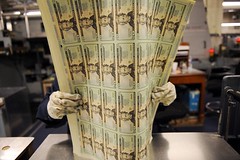 William Bolden makes more money in eight hours than Donald Trump.
William Bolden makes more money in eight hours than Donald Trump.
Combined with Oprah Winfrey.
Combined with Beyonce and Jay-Z.
Bolden, a soft-spoken man who grew up on a Virginia farm, does the math one recent afternoon. If 40,000 sheets of paper travel through the machine he mans each night at the U.S. Bureau of Engraving and Printing, and each one carries 32 $20 bills, that's $25,600,000. All in a single shift.
In a year, that means more than $6.6 billion will pass before his eyes. Last year, Trump, Winfrey and the expecting couple earned, according to Forbes, a combined total of about $422 million.
At the bureau, each weekday, around the clock, men and women like Bolden swipe security badges and walk into the rumbling belly of the C Street building to print what the rest of us are laboring for: Greenbacks.
"I don't think of it as money. Right now, it's just paper," says Bolden, 50, standing in front of a yellow, groaning machine that is spitting out stacks of crisp, untouched bills. His eyes scan for tiny details most people wouldn't notice, such as whether every word on the seal is readable. "Here, we're producing a commodity that the country needs and it has to be correct."
Bolden, a Navy veteran who worked for 16 years in the CIA's print shop before coming to the bureau, speaks of printing with reverence. There is a thrill in that moment of creation, he says, in starting with a blank sheet and ending up with something important. "I'm proud," he says, "that I print something that is used around the world."
To read the complete article, see:
The new alchemists: Blank paper to greenbacks
(www.washingtonpost.com/local/the-new-alchemists-blank
-paper-to-greenbacks/2011/08/31/gIQAoizSwJ_story.html)
ERNIE NAGY'S 2011 CHICAGO ANA DIARY
The Chicago World's Fair of Money was the first national show I have attended. It was an experience which I will never forget; I loved every second of it.
On Thursday night I attended the Token and Medal Society (TAMS) banquet. I found an open seat next to someone who I had not previously met, John Mutch. John is the Maverick editor for TAMS. Mavericks are tokens or medals which do not indicate the city or state of their origin. John and other TAMS members attempt to attribute them to their origin through research. On my other side sat Cliff Mishler.
I asked Cliff what led him to his interest in world coins. He explained to me that he was raised in Vandalia, Michigan, which prior to the civil war was a site on the Underground Railroad. In studying the history of his home town he learned about Liberia, which was colonized in the 1820's by freed American slaves. Cliff started collecting coins of Liberia, and then neighboring countries. Eventually, he helped produce the Standard Catalog of World Coins!
I attended my first meeting of Early American Coppers, Inc. (EAC). In the round-the-room introductions R. W. (Bob) Julian introduced himself as a person who collects information. After the meeting I introduced myself to Bob and told him that I had used his book Medals of the United States Mint, the First Century 1792-1892 to learn about a collection of nine Michigan State Agricultural Society medals which were awarded to the Gale Manufacturing Company from 1862 through 1876 and passed down through my wife's family.
The investigation of these medals was my first extensive foray into numismatic research and Bob's book was the only source I had for the basic information about them. In his description of the medals, Bob mentioned correspondence about deteriorating dies. I told Bob that the evidence of the deterioration could be seen by a progression of rim cuds on the medals which were in my collection. Bob did not retain copies of the correspondence concerning the die failures, but he was able to give me a lead as to where I might be able to obtain it.
Also at the EAC meeting was John Wright, author of The Cent Book, the book I use for die variety attribution of Middle Date Large Cents. Later that day I was in the collector exhibit area and saw John and his wife Mabel reviewing the exhibits. I introduced myself to them told him how much I used and enjoyed John's book. John asked me what I was collecting these days, and I told him that I had an exhibit on Coins in Great American Literature.
It was very rewarding to me to see John spend considerable time studying my exhibit. Then I remembered that in my analysis of the large cents I was exhibiting as representatives of the "Two Broad Coppers" which the new boy held out derisively to Tom Sawyer in the first chapter before Tom pummeled him, I had included a citation to John and his Cent Book! Being able to show that citation to John was the highlight of the week for me.
THE BOOK BAZARRE
THIAN'S COMPILATIONS OF CONFEDERATE TREASURY DOCUMENTS
Although limited in number the existence of these important—albeit rare—volumes cannot be underestimated. When Douglas Ball researched in the National Archives in the 1960s, he was completely ignorant of these Thian compilations of Treasury documents and correspondence. He was even unaware of their use by previous scholars Eugene Lerner or Richard Cecil Todd. Writing in the "Foreword" to the 1972 Quarterman reprint of the Thian Register, Ball wrote: "No history of Confederate finance or history of the Civil War which touches on economic events in the South can ignore these (Thian's) works. The reason for this is simple, as I discovered after nine months' work in going through the same papers." He adds parenthetically: "In my ignorance I did not know the Thian books existed."(2)
Ball continues, "The mass of papers [from the Rebel Archives held by the National Archives] is beyond the patience of any single individual except one who is mad about Confederate finance. After I made copies of the Thian works I found that I had only 300 letters of importance which he did not have, and of these fully 200 were not available to him at the time."(3) Elsewhere Ball says Thian's compilations have proven "a high degree of accuracy,"(4) so much so that although "I [Ball] may have seen the original reports, letter, or ledger entries on note issues, I use the Thian books for ease of citation,"(5) Ball wrote in the "Introduction" to his excellent 1991 work Financial Failure and Confederate Defeat.(6)
Absent patient and time-consuming researches in the National Archives of the original documents themselves or more likely of the microfilm copies prepared after August 1966, they represented a mother's lode of primary evidence for historians, economists and other scholars of 19th-century America.(7)
As elusive as the Thian volumes are, and as problematical as reviewing microfilm over extended periods of time can be, the enormity of Thian's achievements only really became apparent to collectors in generally with the republication of the Thian microfilm materials (Treasury Reports and Correspondence to and from the Treasury) on CD as "Records from the Confederate Treasury" in May 2004. The presentation was perfected when a more comprehensive edition appeared in DVD searchable electronic format in June 2006 as "The Works of Raphael P. Thian." The DVD included the previous Thian publications as well as desirable additions, such as other Thian works and his personal reference albums archived at Duke University.
Collectors, and historians too for that matter, owe a great debt of gratitude to George Tremmel, Tom Carson and Bob Schreiner for these publications. Their DVD makes the Confederate correspondence readily accessible. It is one of the most important events in the history of CSA currency collecting in this writer's opinion.
The correspondence is so much more important historically than Thian's Register. And also the scanning of the Thian's personal albums among the Duke University materials allows collectors, researchers, and historians the opportunity to actually examine the Thian albums page-by-page, which would be prohibitively costly for people traveling to Duke, and would subject these materials to unnecessary endangerment too, I suspect.(8)
Thian believed that the "history of the purse" was as important as the "history of the sword." If Thian had gone no further with his personal quest to perpetuate the "history of the purse" than to publish the five volumes thus far considered he would have performed immeasurable service to history and posterity, but the government clerk had far-reaching additional goals.
To read the complete article, see: Raphael Thian's Tomes Important (www.numismaster.com/ta/numis/Article.jsp?ad=article&ArticleId=23430)
To read the earlier E-Sylum article, see: QUERY: REGISTER OF THE CONFEDERATE DEBT INFORMATION SOUGHT (www.coinbooks.org/esylum_v14n37a11.html)
BYRD POLAR FLIGHTS MEDAL
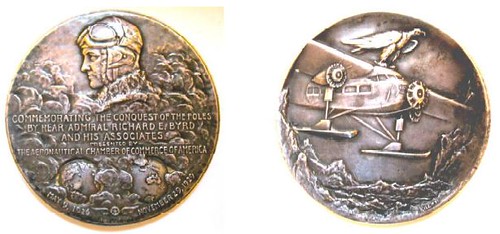
This has to be the finest medal commemorating the exploration achievements of Rear Admiral Richard E. Byrd. We have seen this before, but Harry Waterson brought it to our attention again. The following is from the eBay description.
"Commemorating the conquest of the Poles / by Rear Admiral Richard E. Byrd / and his associates" / Presented by the Aeronautical Chamber of Commerce of America. / May 9, 1926 (flight over the North Pole) November 29, 1929 (flight over the South Pole). Edge marked: William C Haines Meteorologist Byrd Antarctic Expedition 1928-30 Whitehead-Hoag. Minted by Whitehead-Hoag, designed by Julio Kilenyi (ed note: see "Medal of the Month Foundation" December 2010, page 90). Sterling silver (ed note: although it may be silver plated) 6.7 ounces 3.25 inches (about 84mm). eBay PR $933."
QUERY: ALASKA FISH MONEY INFORMATION SOUGHT
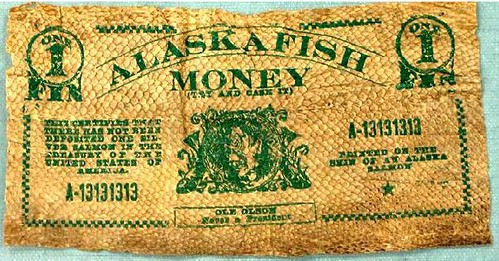
On August 2, the Fairbanks Coin Club was invited to the University of Alaska Museum to view the numismatic items in their collection. This was the most intriguing piece. Does anyone know anything about it?
The legends read: "One 1 Fin, Alaska Fish Money, Try and cash it. This certifies that there has not been deposited one silver salmon in the Treasury of the United States of America, Printed on the skin of an Alaska Salmon, Ole Olson, Never a President." It is printed in green on salmon skin.
INSPIRATIONS FOR HOBO NICKEL CARVINGS
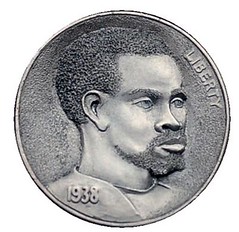
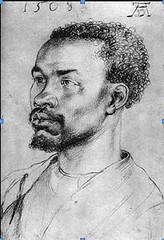
A 500 year old sketch provided Chris DeCamillis RM1183 with the inspiration for this "Durer's Sketch" carving. "In 1508, during the period of the Trans-Atlantic Slave Trade, Albrecht Durer sketched a picture of an anonymous black man. The status of the black man is unknown to us today. By researching the routes of the Trans Atlantic Slave trade, one can speculate about the position of this man. By thoroughly analyzing Durer's sketch, Head of a Negro, we could learn about the man's physical appearance as well as Durer's artistic style." • African American History Through the Arts: Durer's Head of a Negro (cghs.dadeschools.net/african-american/europe/durer.htm) • ~ V-Dubya
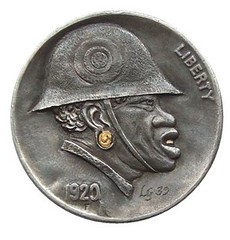
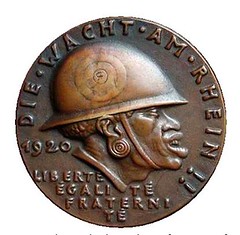
This Lee Griffiths RM712 "Watch on the Rhine" carving was based on Karl X. Goetz' 1920 medal protesting the arrival of black colonial French troops to occupy the Rhine territory. Most certainly a ploy by the French to humiliate the Germans. Goetz was obviously livid with the action. Goetz' medals were produced quickly in order to retain their topical interest and in doing so, the medals became primarily expressions of emotions rather than a well-planned intellectual effort. Still, an almost continuous stream were produced in the form of reasonably priced castings made in base metals. "Text and medal image provided by Henry Scott Goodman at KarlGoetz.com" • The Art Work of Karl X. Goetz: WWI Satirical Series (www.karlgoetz.com/index1.html) • The Watch on the Rhine: The Military Occupation of the Rhineland (ebookee.org/The-Watch-on-the-Rhine-The-Military-Occupation-of-the-Rhineland-_294558.html) • ~ V-Dubya
KOLBE & FANNING SEPTEMBER SALE REMINDER
ALL BIDS MUST BE RECEIVED BY MIDNIGHT SETEMBER 15, 2011
REFER TO THE SALE CATALOGUE FOR DETAILS
THANK YOU IN ADVANCE FOR YOUR PARTICIPATION
Catalogue Available at Our Web Site: www.numislit.com
Printed Catalogues $10.00
KOLBE & FANNING NUMISMATIC BOOKSELLERS
141 W JOHNSTOWN ROAD, GAHANNA OH 43230-2700
(614) 414-0855 • df@numislit.com • GFK@numislit.com
RECORD PRICE FOR AN AUSTRALIAN VICTORIA CROSS MEDAL
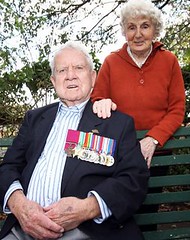 A WAR hero's family shared £770,327 yesterday — after his Victoria Cross was auctioned for the world record sum.
A WAR hero's family shared £770,327 yesterday — after his Victoria Cross was auctioned for the world record sum.
Brave dad-of-four Ted Kenna, who died aged 90, decreed his medal for single-handedly taking out a Japanese machine-gun nest should be sold to provide for his relatives.
They were stunned by a frantic bidding battle in Melbourne, Australia, which saw the gong bought by an anonymous collector. Son Rob said of the fortune: "It was dad's legacy to us."
Only 20 of the medals were awarded to Aussie troops in World War II.
Ted's beat the previous auction record for a VC — £491,567. His 12 grandkids and 19 great-grandchildren will also benefit.
He was a private when he stormed the two-man machine-gun post in New Guinea — killing both of the enemy. The VC was awarded for his "magnificent courage".
To read the complete article, see:
Victoria Cross sells at record £770k in bids war
(www.thesun.co.uk/sol/homepage/news/campaigns/
our_boys/3799227/Victoria-Cross-sells-at-record-770000-in-bids-war.html)
NOTES FROM E-SYLUM READERS: SEPTEMBER 11, 2011
The '5 Dec' Notation on the Type II Quint
Regarding the engraved notation on the Type II Nova Constellatio pattern Quint, Joe Boling writes:
Tom Delorey reports "5 Dec" and you report "Dec 5." The former is a lot more likely to mean "5 decimes" than the latter.
To read the earlier E-Sylum article, see: MORE ON THE TYPE II QUINT (www.coinbooks.org/esylum_v14n36a08.html)
Colonial African Coins Reference Sought
J Briscoe writes:
I'm searching for a good reference book on German East African coins (or Colonial African coins). I've done some searching online and I've come up empty handed. If anyone has any recommendations, it would be greatly appreciated.
New Zealand Mint at the 2011 ANA Convention
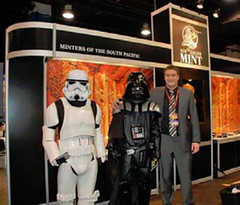 Regarding the Star Wars characters at the New Zealand Mint booth at the 2011 Chicago ANA show, Dick Doty writes:
Regarding the Star Wars characters at the New Zealand Mint booth at the 2011 Chicago ANA show, Dick Doty writes:
Actually, I thought the guys in the Star Wars costumes were just ordinary members of the EAC.
Joe Boling adds:
I was surprised to learn a couple of conventions ago that this mint has no connection with the New Zealand government. It is a private mint that happens to have contracts to produce legal tender coinage for some Pacific region nations, but is not a government entity. I don't understand why the government of NZ allows its name to be used in this commercial manner.
A Half Dollar With A Secret Compartment
Web site visitor Robert V. Gonzalez writes:
I have a Liberty 1942 half dollar that my father gave me. He found it 50 years ago on the street in NYC. When he pick it up the coin opened and it had a Queen Isabella of Spain copper cover inside, and looks like it was a secret compartment. Do you know anything about this coin, where it came from, what it was used for and what it could be worth?
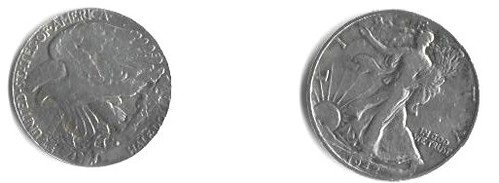
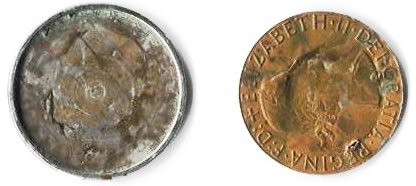
On Treasure Trove Laws
Finding treasure is rarely as romantic or swashbucklingly exciting as Robert Louis Stevenson would have it. But that does not deter amateur prospectors in Britain. Detectorists, often affiliated with local clubs, are known to comb the sceptred isle in search of buried booty, assisted by beeping gadgets. In recent weeks, they have helped to uncover significant hoards of Roman coins in Wales and Devon, which are expected to yield valuable insights into the society of our erstwhile be-togaed conquistadors.
Encouraging and exploiting these chance discoveries requires good policy. With spending cuts set to trim the budgets of state-funded archaeological expeditions, it seems sensible to allow enthusiasts to bolster the work of professionals. But amateurs must be convinced to report their finds, and sometimes to relinquish them to the state.
Britain has tried to strike a balance between respecting detectorists' enterprising spirit and protecting the nation's cultural patrimony. Scouring the ground for antiquities is perfectly legal here, provided you have the permission of the landowner. If you find prehistoric metal artefacts or anything gold or silver over 300 years old, the delightfully-titled Treasure Act requires you to report it—but you will be rewarded with a tidy payment of the full market value of the stash, in the event that the state decides to buy it.
To read the complete article, see: X marks the spot (www.economist.com/blogs/blighty/2011/08/treasure-hunting)
ROMAN REPUBLICAN COINS IN NUMISMATICA ARS CLASSICA SALE
An E-Sylum reader writes:
This may be too commercial for The E-Sylum, but it will be a very important sale. The full catalogue is up on SixBid.
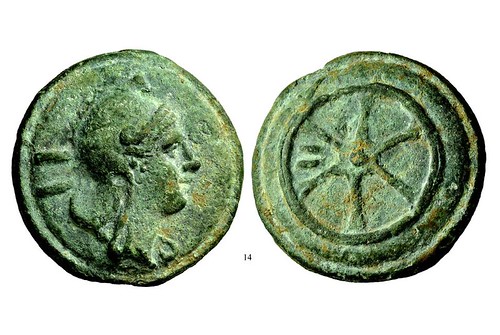
On October 5th, Numismatica Ars Classica will offer the first part of perhaps the most complete collection of ancient Roman Republican coins ever offered for public sale. The Roman Republic spans the period from when Rome was a small central-Italian city state until the end of the Republic in 31 BC, when Octavian defeated Marc Antony at the battle of Actium, and the Roman Empire began. The first sale of the "RBW Collection" will cover the period from the beginning of Roman coinage in the 4th century BC up to the Social War in 91 BC, when several Italian states rose up against Rome, and almost toppled her. The coinage from the Social War until the end of the Republic will be offered by Numismatica Ars Classica in the spring of 2012.
The collection, formed over the past 50 years, includes coins struck in gold, silver, and bronze, as well as examples of the dramatic large cast coins which passed for currency in Rome's earliest days. The first sale will include one example of nearly every coin type known for this period, plus 29 types which are not recorded in the standard references for the series. And, as a measure of the rarity of the coins offered, five are unique, and five others are known in only two examples.
he RBW Collection includes coins from most of the major collections sold in the past half-century, including such famous collectors as Enrico Caruso, Clarence Bement, Virgil Brand, Sir Arthur Evans, and John Works Garrett; the specific provenance of nearly every piece is provided. Clearly, this sale will be a once in a generation opportunity for collectors of ancient coins. Catalogues are available from Numismatica Ars Classica, Zürich.
At the tender age of ten, I first discovered an interest in collecting coins (I am convinced that the propensity to collect is a genetically inherited condition). After a few years of dabbling with Whitman "penny boards", US type coins, and foreign crowns, I bought my first Roman Republican denarius in a Lu Riggs auction in 1960, and was amazed that a coin of such antiquity, beauty, and historical interest could be purchased for such a modest price.
Shortly thereafter I purchased a copy of Sydenham's wonderful 1952 catalogue of the Republican coinage and, after reading it carefully, was delighted to find that I could identify and attribute virtually any Republican coin which I encountered. The Republican denarii appealed to me as a series because they combined the beauty and diversity of types of Greek coinage (which I found lacking in Roman Imperial coins, with their repetitive portraits of the emperor combined with stylized representations of various deities), but still formed a cohesive and uniform series (the absence of which in the Greek series thoroughly intimidated me).
Another major milestone in my collecting career occurred in 1969, when I personally attended my first major auction sale: the collection of Thomas Olive Mabbot, sold by Hans Schulman (and idiosyncratically catalogued by Hans Holzer) at the Waldorf Astoria. There I was fortunate to meet Charles Hersh, one of the editors of Sydenham's book, and a great collector and student of the coinage of the Roman Republic.
Charles broadened and deepened my perspective as a collector, and introduced me to the fascinating world of scholarly research and publication. He was one of the dwindling numbers of "gentleman scholars", whose principal occupation was non-academic, but whose scholarly publications were universally accepted as authoritative. Charles became my numismatic mentor, and I would visit him regularly.
To read the complete article, see: Most complete collection of ancient Roman Republican coins ever offered for public sale (www.artdaily.org/index.asp?int_sec=2&int_new=50121)
MORE ON THE LEGALITY OF LIBERTY DOLLARS
As ANA chief judge, I had already made a ruling that the Liberty Dollar exhibit could be shown, based on Coin World's reporting in April, but the ANA general counsel wanted the Charlotte US attorney's office to put in writing what Coin World had reported. So we did not go ask a different government office for an opinion - we went right back where Coin World had obtained their original information.
However, this time the response was not as benign as it had been last spring. Not only would they not confirm that holding and exhibiting the material was not in itself criminal, they made statements that it is contraband and would be subject to seizure. We went back with a request to allow exhibiting the material if accompanied by a statement that the items were being exhibited for educational purposes only. The office would not respond further.
ANA has an exhibit rule that says "Forged, spurious, or counterfeit material and copies or replicas may not be displayed unless each such item is described as such in the exhibit and unless such items are displayed for educational purposes. No such item will be displayed in violation of United States law or government regulations."
It's the second sentence that applies here - if the material is contraband, then it violates one or more statutes or regulations. With a US attorney calling it contraband, we had no choice but to disallow the exhibit.
Hopefully someone will be able to bring reason to the government's attention and get this advisory opinion reversed. The offending medals are no more than silver rounds, and any number of other issuers' products bear the same features that the government found so offensive in this case.
To read the earlier E-Sylum article, see: LIBERTY DOLLARS MAY BE SUBJECT TO SEIZURE (www.coinbooks.org/esylum_v14n37a19.html)
RENAISSANCE EXHIBIT INCLUDING MEDALS HEADED FOR NEW YORK
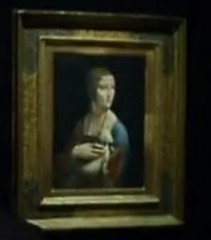 New York's Metropolitan Museum of Art joined with a number of German museums to mount an extensive exhibition of Reniassace art work. The exhibit includes paintings, sclpture, sketches -- and medals.
New York's Metropolitan Museum of Art joined with a number of German museums to mount an extensive exhibition of Reniassace art work. The exhibit includes paintings, sclpture, sketches -- and medals.
It just opened in Berlin's Bode Museum the last week of August and continues through November 25. Therafter it travels to New York to open at the Metropolitan Museum of Art in December and continues until mid-March 2012.
The exhibition demonstrates the evolution of Italian portraits during the 15th century with some 170 works of art.
Click on this URL to view a video of MMOA curator Keith Christensen describing the exhibit as he mentions medals in this major Renaissance exhibition: Renaissance Art Exhibit Kicks-Off in Berlin, Germany (english.ntdtv.com/ntdtv_en/news_europe/2011-08-25/renaissance-art-exhibit-kicks-off-in-berlin-germany-.html)
ANOTHER NEW ZEALAND MEDAL THIEF CAUGHT
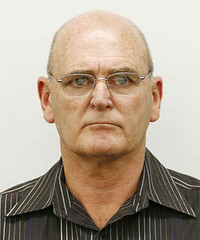
A former employee of the National Army Museum in Waiouru, who has been charged with stealing more than 800 of its medals, is believed to have served for 26 years as a territorial soldier and also as a peacekeeper in Bougainville.
Keith John Davies, 57, was arrested by police at Wellington Airport yesterday afternoon after voluntarily flying in from Australia.
He then appeared in Wellington District Court charged with the theft of 843 medals worth about $256,000, obtaining property by deception, false accounting and unlawfully exporting New Zealand antiquities.
Stolen military history books and memorabilia worth $26,000 also form part of the police case, which took 14 months to build with the help of Australian Federal Police and the New Zealand Defence Force.
Davies was an employee at the museum between 1995 and 2002, when police believe the thefts took place.
A haul of medals was found during a police search of his Queensland home in July. Police said others had been found in Britain, New Zealand and possibly the United States.
To date, 300 of the medals have been recovered, worth about $120,000.
To read the complete article, see:
Medal theft accused served as territorial
(www.stuff.co.nz/national/crime/5544458/Medal-theft
-accused-served-as-territorial)
BOOKSHELVES EVOLVE FOR THE POST-BOOK ERA
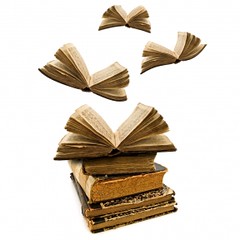 If you needed any more proof that the age of dead-tree books is over take a look at these alarming style changes at Ikea: the furniture manufacturer's iconic BILLY bookcase – the bookcase that everyone put together when they got their first apartment and, inevitably, pounded the nails wrong into – is becoming deeper and more of a curio cabinet. Why? Because Ikea is noticing that customers no longer buy them for books.
If you needed any more proof that the age of dead-tree books is over take a look at these alarming style changes at Ikea: the furniture manufacturer's iconic BILLY bookcase – the bookcase that everyone put together when they got their first apartment and, inevitably, pounded the nails wrong into – is becoming deeper and more of a curio cabinet. Why? Because Ikea is noticing that customers no longer buy them for books.
This isn't quite the canary in the coal mine – think of it as a slight tickle in the mine foreman's throat – but all signs are pointing to the end of the physical book. There are plenty of analogs to this situation. When's the last time you saw a casette tape rack sold outside of Odd Lots? What about the formal "stereo cabinet" with plenty of room for records? What about Virgin Megastores?
As much as it pains me to say this and as horrible as it sounds, the book is leaving us.
The Economist writes:
Next month IKEA will introduce a new, deeper version of its ubiquitous "BILLY" bookcase. The flat-pack furniture giant is already promoting glass doors for its bookshelves. The firm reckons customers will increasingly use them for ornaments, tchotchkes and the odd coffee-table tome—anything, that is, except books that are actually read.
Will bookstores disappear? I think so. With the rise of popular fiction appearing on e-readers, I think the paperback will be the first to go and all that will be left is the "curio" hardback. Then I look forward to a half decade of the publishing industry scrambling to stem piracy and flail wildly at consumers, then hardware manufacturers, then finally settle into the long-fall doldrums the music industry is now facing.
To read the complete article, see: The End Of Books: Ikea Is Changing Shelves To Reflect Changing Demand (techcrunch.com/2011/09/09/death-of-books/)
FEATURED WEB PAGE: U.S. MINT'S SEPTEMBER 11TH MEDALS
This week's Featured Web Page is an earlier E-Sylum article about the U.S. Mint's medal commemorating the events of September 11, 2001. I understand it is now one of the mint's best-selling medals of all time, and rightly so. It's a great design that deserves wide distribution.
The new official U.S. Mint medal commemorating the September 11, 2001 terror attacks has gone on sale. Some of the proceeds will be used to help fund the National 9/11 Memorial and Museum near the former World Trade Center site in New York. Kudos to the U.S. Mint's Donna Weaver and Phoebe Hemphill. for an inspired obverse design. The flame of Lady Liberty's "Lamp of Remembrance" recalls the flames seen from the World Trade Center towers that fateful morning. This effect is more obvious in the image of the struck medal than the original artwork unveiled earlier.
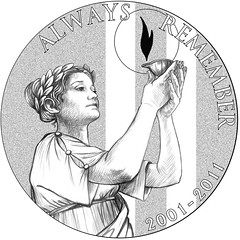
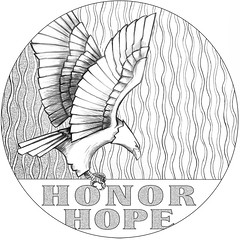
www.coinbooks.org/esylum_v14n26a12.html
